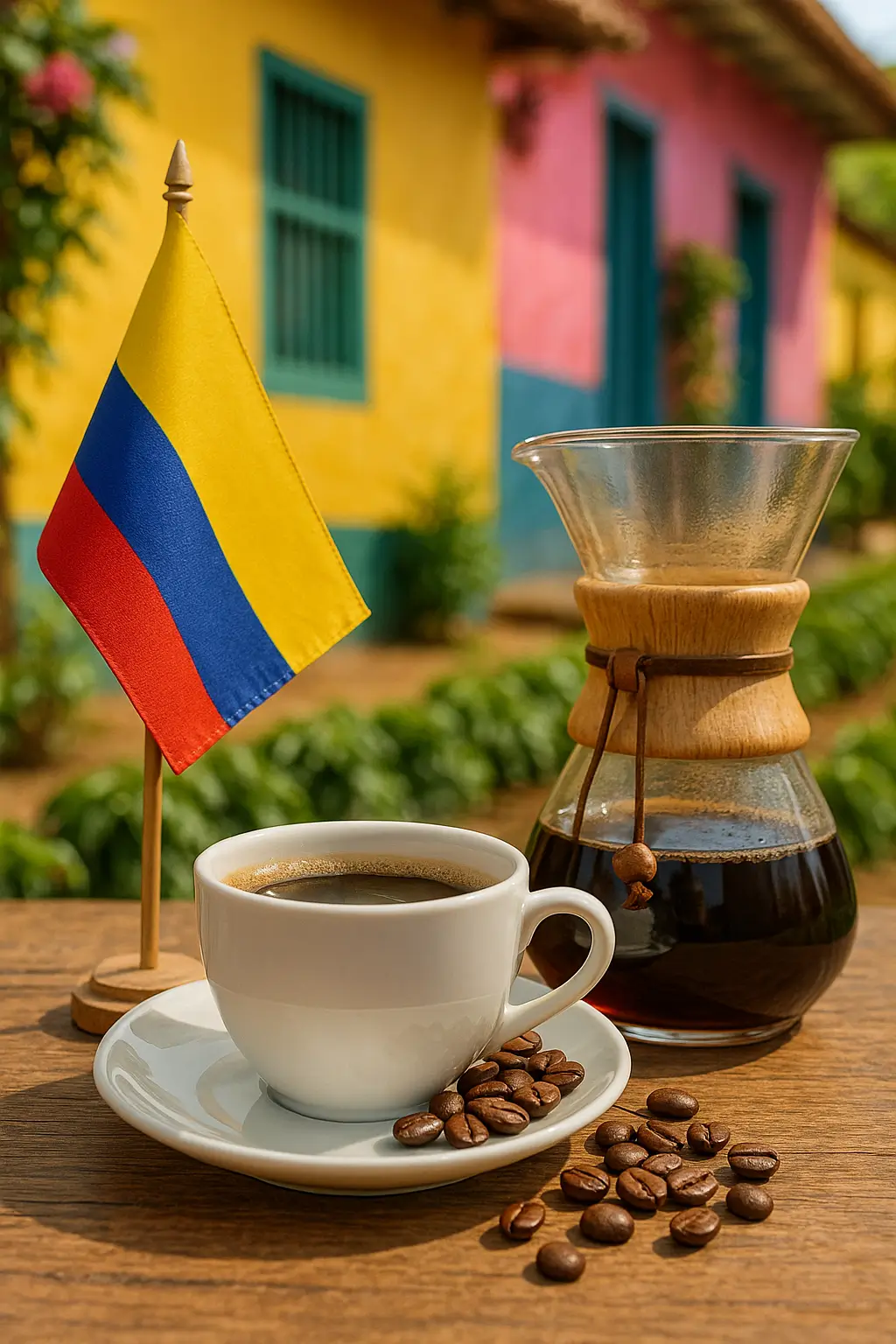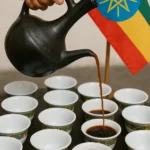Colombian Coffee is known worldwide. It earned its reputation for unique flavor and great quality. What makes it so special? Let’s trace its journey from the farm to your cup and explore its unique flavors.
- What is the signature flavor profile of Colombian coffee?
- Colombia’s unique land: The secret to its coffee?
- From cherry to cup: How do they process Colombian coffee?
- Key varieties and famous regions: What makes them special?
- How do standards and certifications protect Colombian coffee?
- The essence of Colombian coffee: What defines it?
What is the signature flavor profile of Colombian coffee?
Colombian coffee often offers a balanced body, bright acidity, and a clean taste. This mix makes it versatile. Many people enjoy its taste.
Sweet, fruity, nutty: How does Colombian coffee taste?
Colombian coffee has sweet, fruity, and nutty notes. You might taste caramel or rich chocolate. Look for citrus notes like orange or lime. Berries, cherries, and stone fruits are also common. A subtle nutty taste, like toasted walnuts, balances these flavors. Sometimes, you will find hints of flowers, honey, or spice. This complexity gives it its famous taste.
What makes Colombian coffee clean, bright, and smooth?
Colombian coffee is clean, bright, and smooth. Its acidity is clear, like wine, and sparkling. It never tastes sharp or bitter. This makes it refreshing to drink. It finishes smoothly, often with a sweet aftertaste. People love to drink it black because of these flavors. It’s a great breakfast coffee. It tastes strong, yet feels perfectly balanced.
Key flavor characteristics:
- Balanced body,
- Bright, sparkling acidity,
- Clean taste,
- Smooth finish,
- Subtle sweet aftertaste.
Colombia’s unique land: The secret to its coffee?
Colombia’s unique terroir is why Colombian coffee tastes so distinct. Its geography and climate create a perfect environment for growing coffee. These natural elements shape the bean’s growth and its final taste.
High elevation and volcanic soils: How do they help?
High elevation and volcanic soils help make Colombian coffee special. Coffee grows mostly on the Andes Mountains. Farms sit high up, from 1,200 to 2,200 meters. High places slow cherry ripening. This gives beans more time to build rich flavors. Volcanic soils are rich in minerals. They feed the coffee plants well. These soils are key to great coffee. Altitude and soil combine to grow unique beans.
Equatorial location and climate: How do they benefit the coffee?
Colombia’s equatorial location and consistent climate are a big plus for Colombian coffee. Near the equator, Colombia stays warm all year. Coffee areas see temperatures between 18°C and 24°C. This steady warmth stops frost. It keeps tender coffee plants safe from sudden changes. Rainfall is steady and spread out all year. This moisture helps flowers bloom and fruit grow constantly. Some regions even get two harvests a year. These steady conditions mean consistent, quality coffee.
Diverse microclimates and natural shade: How do they influence the coffee?
Diverse microclimates and natural shade influence Colombian coffee a lot. Humidity, sunlight, and temperature vary across Colombia’s mountains. This creates many small microclimates. These unique spots grow many different flavor profiles across the country. Clouds and humidity protect coffee plants from harsh sun. This helps them grow steadily. Many farms use native trees for natural shade. Shade keeps temperatures mild. It boosts local wildlife and improves soil. This helps make better beans.
From cherry to cup: How do they process Colombian coffee?
Colombian coffee goes through careful processing from cherry to cup. It starts with careful harvesting. These methods greatly impact the coffee’s flavor, quality, and character. Every step protects the bean.
Selective handpicking: Why is it important for quality?
Selective handpicking is key to quality Colombian coffee. Farmers handpick each coffee cherry. They choose only the ripe ones. This ensures all beans ripen evenly. It means better overall quality. Careful picking makes a balanced, high-quality cup. Strip-picking, where all cherries come off at once, gives lower quality. Ripeness varies with that method.
The washed (wet) process: How does it work?
The dominant washed (wet) process for Colombian coffee has several steps. First, machines remove the outer skin and pulp from the cherry. Next, beans, still sticky with mucilage, ferment in water tanks. This breaks down the sticky layer. After fermentation, thorough washing removes any remaining stickiness. Finally, beans dry under controlled conditions. This method consistently gives you a clean, bright, and acidic cup. People praise its clear flavors.
Other processing methods: What are they?
Other processing methods exist for Colombian coffee, but they are less common than the washed process. The Natural (Dry) Process means drying whole cherries under the sun after harvest. The fruit ferments and dries on the bean. This gives the coffee sweeter, fruitier tastes and a heavier body. The Honey Process removes some pulp before drying, but leaves some sticky mucilage on the bean. This gives flavors with moderate sweetness and body. It sits between washed and natural methods. Each method gives the bean unique tastes.
Drying and post-processing: How do they perfect Colombian coffee?
Drying and post-processing ensure perfect Colombian coffee. After initial processing, growers dry beans on patios or raised beds. They dry them until moisture hits 10-12%. Controlled drying stops spoilage. It keeps the bean’s quality intact. Next, hulling removes the parchment. Then, beans are graded by size and quality. Workers sort beans by hand or machine. They remove defects and ensure color matches. Only top-grade beans get shipped.
Key varieties and famous regions: What makes them special?
Colombian coffee comes only from Arabica plants. Farmers grow them in famous coffee regions. Colombia grows 100% Arabica. This commitment helps its global name for quality.
Why does Colombia grow only Arabica?
Colombia grows only Arabica beans. They offer complex flavors and great aromas. This focus sets Colombia apart in the global market. Common Arabica types include Typica, Bourbon, and Caturra. Farmers also grow Maragogipe, known for large beans. Tabi is a rust-resistant hybrid with excellent cup quality. Variedad Colombia is another key hybrid. It resists rust and gives high yields. This proved vital during past rust outbreaks.
Castillo: Why is it Colombia’s coffee staple?
Castillo is the modern Colombian coffee staple. It resists disease and gives high yields. The “Colombia sin Roya” program developed Castillo. It strongly resists Coffee Leaf Rust and Coffee Berry Disease. This helps farmers produce coffee steadily, even when conditions are tough. Castillo is the newest and most planted variety in Colombia today. It tastes rich and has large beans. This adds a lot to Colombia’s coffee output and makes it more resilient. Its wide use shows its importance to today’s Colombian coffee farms.
Famous coffee regions: Where does Colombian coffee grow?
Colombia’s most famous coffee regions are Medellín, Armenia, and Manizales. These areas are known for high-quality Arabica coffee. Their unique environments give the coffee its distinct profile. These regions have high altitudes and good climates. This gives the coffee its unique acidity and flavor. Colombia’s coffee zones, like the Andes Mountains, offer diverse geography. This creates subtle taste variations. Yet, they all keep the balance and brightness typical of Colombian coffee.
- Typica: An original variety with tall plants, producing complex flavors despite lower yields.
- Bourbon: Known for semi-sweet flavors and higher yields compared to Typica.
- Caturra: A dwarf mutation of Bourbon, characterized by small plants, dense cherry clusters, and high yields.
- Castillo: The most widely planted modern variety, highly resistant to disease, high-yielding, and adaptable.
- Tabi: A rust-resistant hybrid introduced in 2002, celebrated for its exceptional cup quality.
How do standards and certifications protect Colombian coffee?
Certifications and quality standards protect Colombian coffee. They prove its authenticity and keep its premium market spot. These steps protect its origin. They boost its global reputation. They let Colombian coffee growers enter premium markets and get better prices.
Certifications: How do they ensure quality and global recognition?
Certifications ensure quality and international recognition for Colombian coffee. They follow strict global standards. Certifications like CAFECERT follow strict international standards (like ISO/IEC 17065:2012). This makes sure all Colombian coffee meets global quality standards. The Colombian Coffee Growers Federation (FNC) holds ISO 9001 for quality and ISO 14001 for environmental management. These show their dedication to quality and eco-friendly practices. These certifications build trust with buyers. They help this specialty coffee reach markets worldwide.
Geographic Indications: How do they protect Colombian coffee?
Protecting origin through Geographic Indications (GIs) helps Colombian coffee a lot. Legal tools protect its origin. These include Protected Geographical Indication (PGI) in the EU and Designations of Origin (DOP) in South America. These GIs link coffee quality and authenticity directly to its region. This legal tag sets Colombian coffee apart. It adds great value in global markets. It stops fake products. It makes sure you get genuine, high-quality coffee. This system highlights the unique traits from Colombia’s distinct land.
Branding and market access: How do they impact Colombian coffee?
Branding and market access impact Colombian coffee a lot. The Colombian Coffee Growers Federation strategically uses branding. The Juan Valdez brand is a prime example, along with certification marks and GIs. This strategy built a strong, global identity for Colombian coffee. This lets Colombian coffee sell at premium prices. It’s often much higher than generic coffees. Certifications and quality standards open doors to special markets. Buyers there want traceability, sustainability, and high health standards. This means better pay for coffee farmers.
The essence of Colombian coffee: What defines it?
| Aspect | Description |
|---|---|
| Flavor Profile | Balanced, bright, clean. Notes of caramel, chocolate, citrus, berries, nuts. |
| Terroir | High altitude, volcanic soil, consistent equatorial climate, diverse microclimates. |
| Processing | Selective handpicking, dominant washed process, controlled drying. |
| Varieties | 100% Arabica (Typica, Bourbon, Caturra, Castillo, Tabi, Variedad Colombia). |
| Quality & Certifications | Strict standards, GIs, FNC, Juan Valdez brand. |
Colombian coffee stands out for its unique land, careful processing, diverse Arabica types, and strict certifications. These all make its quality and flavor famous. It remains a global standard for premium coffee. Its balanced body, bright acidity, and clean taste come from Colombia’s volcanic high-altitude regions. Conditions there are perfect. Hand-harvesting and processing, mostly the washed method, refine these traits further. Brands like Juan Valdez show the consistent excellence supported by the Colombian Coffee Growers Federation (FNC). Ready for authentic Colombian coffee? Find a local roaster or specialty coffee shop. Taste the difference yourself.









